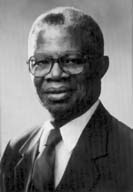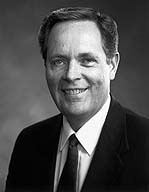“Burgeoning Brazil: The Blessings and Challenges of Growth,” Ensign, Jan. 1993, 79–80
Burgeoning Brazil: The Blessings and Challenges of Growth
Brazil is a giant in South America, bordering all but two of the continent’s countries. Latter-day Saints, barely a footnote in Brazilian national statistics three decades ago, are now helping shape their country’s future. To learn more about the Church in Brazil, the Ensign talked with Elder Harold G. Hillam of the Seventy, Brazil Area president, and Elders Helvécio Martins and Dallas N. Archibald of the Seventy, counselors in the area presidency.



Elder Helvécio Martins Elder Harold G. Hillam Elder Dallas N. Archibald
Question: How many Church members are there in Brazil?
Answer: About 400,000 Latter-day Saints among Brazil’s 150 million people. There are fifteen missions and eighty-five stakes, and our membership has been growing at the equivalent of a stake per month.
Q: And yet in Brazil in the 1960s, Latter-day Saints were not even listed among the religious groups whose numbers were statistically significant. How has this growth come about?
A: The groundwork was laid just as it has been wherever the Church is established anywhere in the world. Missionaries first arrived in the country in 1935. There was a small core of faithful members during the World War II years, and then their numbers began to increase after 1950. But there has been an explosion of growth since the dedication of the São Paulo Temple in 1978.
Q: What do you think is the reason the Brazilian people are so receptive to the Church?
A: They’re very friendly people—very open, very ready to receive new knowledge. It’s easy to talk with them and their families about the gospel.
The word hope is a key in looking at why they come into the Church so readily. First, the gospel offers them hope in eternal life, hope in the things that the Savior can bring to pass in their lives. That is one of the strengths we see in them as members—a great desire to follow the Savior.
Second, the Church offers them hope in their temporal lives, as they go forward day after day trying to better their families’ economic positions. While we have members from all walks of life and economic levels, some Latter-day Saints struggle with the high inflation, high unemployment, and severe underemployment that are such serious challenges for Brazil. The gospel offers help there too. When we teach people correct principles of living, they usually find that they can take themselves out of the slums.
We are able to offer members some help in finding employment now as we begin to build a job network. We are particularly concerned about helping returned missionaries and heads of households find jobs that will provide adequate support.
Q: With the pace of growth in Brazil, do you rely on returned missionaries to help fill the ranks of Church leadership?
A: Yes. They are young, but age is not the key factor in leadership. The key is their level of spiritual maturity, and our young men and women who serve missions come back with very valuable experience that prepares them for leadership. We emphasize missionary preparation at the local level, partly because we know the missionaries will be our future leaders. But there is a more immediate need. We need greater numbers of missionaries in the field.
Q: Are there still populous areas where the gospel is not being preached?
A: Nearly one-fifth of the cities in Brazil with a population of more than 100,000 do not have missionaries. One large suburb of São Paulo has more than a million people—and only two missionaries. The pool of people still to hear the gospel is vast because parts of the country are so intensely urban. Brazil has two of the world’s ten largest cities—São Paulo and Rio de Janeiro.
The number of missions in Brazil could easily be doubled and still leave more than enough work for missionaries. The members are praying for more missions—and more temples.
Q: Is it difficult for many of them to visit the temple?
A: To answer that question, you have to look more closely at the size of Brazil. It is nearly as big as the forty-eight continental United States plus an additional area the size of Texas. Much of western Europe would fit comfortably within the Amazon Basin—in fact, within the boundaries of the Brazil Manaus Mission. When a group of Saints from Manaus visited the temple in December, they had to travel three days downriver by boat, then transfer to buses for a two-day ride to São Paulo.
Those who come to the temple come with great faith. Despite the sacrifices some of them must make, attendance is growing. Our biggest challenge right now is that we have only one temple in Brazil.
Q: How are Latter-day Saints having an impact on their country?
A: A growing number of Latter-day Saints are leaders in their communities, in local government, and in their businesses or professions. They are known for their integrity and their high standards. Our youth stand out not only because of their standards but also because of their happiness and their willingness to serve. The examples of individual members have helped give the Church a very positive image in Brazil.
People like Moroni Bing Torgan and Elder Martins, who serves in our area presidency, have led the way.
Brother Torgan distinguished himself for integrity and diligence in his law enforcement career while at the same time serving in a succession of Church leadership roles. Now he is a member of the national legislature.
Elder Martins once had an experience that illustrates the respect many Brazilians have for the Church and its members. Several years before his call as a General Authority, he was chosen for a promotion in his company, and his employer let him know that the selection was made not only because of his professional ability but also because he was a Mormon bishop. The employer made it clear that he saw Bishop Martins’s Church calling as an important assurance of integrity and willingness to serve as needed.
Q: What does the growth of the Church in Brazil mean for the country?
A: Many people don’t realize how potentially prosperous Brazil is, not just economically, but in spiritual riches.
In reality, the future of Brazil is tied to the gospel. The world will see great changes in the country, but we believe these will come through the influence and spread of the gospel. That’s why we feel a great responsibility to be sure that the Church is moving along rapidly and to teach diligently the principles of truth and faith in the Lord Jesus Christ, so that more people will be able to change their lives. The Brazilian people are a great people, very resilient. They have been through many hardships, but they are still optimistic. They look for better days in this life, and when we bring them the gospel, many of them recognize immediately that the Church offers what they have been looking for.